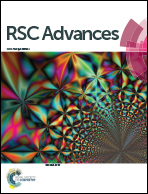Onion-derived activated carbons with enhanced surface area for improved hydrogen storage and electrochemical energy application†
Abstract
High surface area activated carbons (ACs) were prepared from a hydrochar derived from waste onion peels. The resulting ACs had a unique graphene-like nanosheet morphology. The presence of N (0.7%) and O content (8.1%) in the OPAC-800 °C was indicative of in situ incorporation of nitrogen groups from the onion peels. The specific surface area and pore volume of the best OPAC sample was found to be 3150 m2 g−1 and 1.64 cm3 g−1, respectively. The hydrogen uptake of all the OPAC samples was established to be above 3 wt% (at 77 K and 1 bar) with the highest being 3.67 wt% (800 °C). Additionally, the OPAC-800 °C achieved a specific capacitance of 169 F g−1 at a specific current of 0.5 A g−1 and retained a capacitance of 149 F g−1 at 5 A g−1 in a three electrode system using 3 M KNO3. A symmetric supercapacitor based on the OPAC-800 °C//OPAC-800 °C electrode provided a capacitance of 158 F g−1 at 0.5 A g−1. The maximum specific energy and power was found to be 14 W h kg−1 and 400 W kg−1, respectively. Moreover, the device exhibited a high coulombic efficiency of 99.85% at 5 A g−1 after 10 000 cycles. The results suggested that the high surface area graphene-like carbon nanostructures are excellent materials for enhanced hydrogen storage and supercapacitor applications.



 Please wait while we load your content...
Please wait while we load your content...